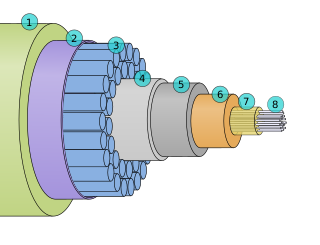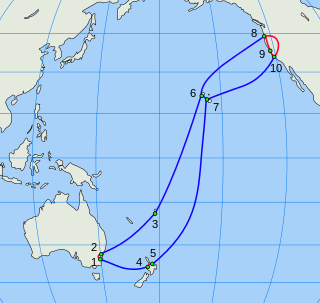Related Research Articles

A submarine communications cable is a cable laid on the seabed between land-based stations to carry telecommunication signals across stretches of ocean and sea. The first submarine communications cables were laid beginning in the 1850s and carried telegraphy traffic, establishing the first instant telecommunications links between continents, such as the first transatlantic telegraph cable which became operational on 16 August 1858.

The Southern Cross Cable is a trans-Pacific network of telecommunications cables commissioned in 2000. The network is operated by the Bermuda-registered company Southern Cross Cables Limited. The network has 28,900 km (18,000 mi) of submarine and 1,600 km (990 mi) of terrestrial fiber optic cables, all which operate in a triple-ring configuration. Initially, each cable had a bandwidth capacity of 120 gigabit/s. Southern Cross offers capacity services from 100M/STM-1 to 100 Gbit/s OTU-4, including 1G, 10G and 40G Ethernet Private Line services.
Fibre-optic Link Around the Globe (FLAG) is a 28,000-kilometre-long fibre optic mostly-submarine communications cable that connects the United Kingdom, Japan, India, and many places in between. The cable is operated by Global Cloud Xchange, a subsidiary of RCOM. The system runs from the eastern coast of North America to Japan. Its Europe–Asia segment was the fourth longest cable in the world in 2008.
SEA-ME-WE3 or South-East Asia - Middle East - Western Europe 3 is an optical submarine telecommunications cable linking those regions and is the longest in the world. Completed in late 2000, it is led by France Telecom and China Telecom, and is administered by Singtel, a telecommunications operator owned by the Government of Singapore. The Consortium is formed by 92 other investors from the telecom industry. It was commissioned in March 2000.

South East Asia–Middle East–Western Europe 4 is an optical fibre submarine communications cable system that carries telecommunications between Singapore, Malaysia, Thailand, Bangladesh, India, Sri Lanka, Pakistan, United Arab Emirates, Saudi Arabia, Egypt, Italy, Tunisia, Algeria and France.

Pangea is a submarine telecommunications cable system transiting the North Sea connecting UK with Denmark and Netherlands. By 2002, it was no longer in service. It consisted of two widely separated submarine segments - Pangea North and Pangea South.
Broadband Internet in Israel has been available since the late 1990s in theory, but it only became practically accessible to most customers in 2001. By 2008, Israel had become one of the few countries with developed broadband capabilities across two types of infrastructure—cable and DSL—reaching over 95% of the population. Actual broadband market penetration stands at 77%, ranked 7th in the world. In 2010, Israel was ranked 26th in The Economist's Digital Economy Rankings. In 2022, Israel was ranked first for digital quality of life by Surfshark.
I-ME-WE is a 12,091-kilometre (7,513 mi) submarine communications cable system linking Europe and India via the Middle East. At launch, the design capacity was 3.84 Tbit/s, but after upgrades by Mitsubishi Electric in 2016, the new design capacity was rated at 5.6 Tbit/s. The cable entered service in December 2010.
Europe India Gateway (EIG) is a submarine communications cable system that connects the U.K., Portugal, Gibraltar, Monaco, France, Libya, Egypt, Saudi Arabia, Djibouti, Oman, United Arab Emirates, and India.
Equiano is a private transatlantic communications cable that connects western Europe (Portugal) with southern Africa. Branching points along the way connect to Togo, Nigeria, the island of St. Helena and Namibia.
FASTER is a trans-Pacific submarine communications cable that went live during the last week of June 2016. The cable has a total length of approximately 11,629 km and a capacity of 60Tb/s.
South East Asia–Middle East–Western Europe 5 is an optical fibre submarine communications cable system that carries telecommunications between Singapore and France.
West Indian Ocean Cable Company (WIOCC) operates as a wholesaler, providing capacity to international telecoms, cloud operators, content providers and internet service providers within and out of Africa. WIOCC offers carriers connectivity to over 550 locations across 30 African countries – utilising more than 75,000 km (47,000 mi) of terrestrial fibre and 200,000 km (120,000 mi) of submarine fibre-optic cable. WIOCC's international network reach currently extends to 100 cities in 29 countries in Europe and more than 700 cities in 70 countries globally.
Asia-Africa-Europe 1 (AAE-1) is a 25,000 km submarine communications cable system from South East Asia to Europe across Egypt, connecting Hong Kong, Vietnam, Cambodia, Malaysia, Singapore, Thailand, Myanmar, India, Pakistan, Oman, UAE, Qatar, Yemen, Djibouti, Saudi Arabia, Egypt, Greece, Italy, and France. The AAE-1 cable has capacity of at least 40 terabits per second (Tbit/s) to supply the broadband market across Asia, Africa and Europe. In July 2017, it was launched for commercial services and is the longest submarine cable system in over a decade.
South East Asia–Middle East–Western Europe 6 is an in-progress optical fibre submarine communications cable system that would carry telecommunications between Southeast Asia, the Middle East, and Western Europe. Construction began in early 2022. It is expected to be operational in the first quarter of 2025 The expected cable length is 19,200 km and it has a design capacity of 126 Tbit/s, using SDM technology.
The Pacific Light Cable Network (PLCN) is a proposed cable system in the Pacific Ocean. Partners in the project include Meta Platforms and Google.
Grace Hopper is a private transatlantic communications cable that connects the United States of America with the UK (Bude) and Spain (Bilbao). It was announced by Google in 2020 and scheduled to go live in 2022. The US to UK (Bude) leg went live on 27 September 2022.
The New Cross Pacific Cable System (NCP) is a proposed cable system in the Pacific Ocean.

PEACE Cable, which stands for Pakistan and East Africa Connecting Europe, is a submarine cable project designed to facilitate data transmission between Asia, Europe, and Africa. It is owned by Peace Cable International, a subsidiary of Hengtong Group. The 15,000 km cable system is deployed along the seafloor of the Indian Ocean, the Red Sea and the Mediterranean Sea, with plans to extend the cable length to 25,000 km. It is based on WSS ROADM technology with a design capacity of 24 Tbit/s per fiber pair. The cable entered service and became fully operational in December 2022.
References
- ↑ "Blue-Raman - Submarine Networks". www.submarinenetworks.com. Retrieved 2022-11-10.
- 1 2 "Announcing the Blue and Raman subsea cable systems". Google Cloud Blog. Retrieved 2022-11-10.
- 1 2 "Why Egypt became one of the biggest chokepoints for Internet cables". Ars Technica. 2022-11-03. Retrieved 2022-11-10.
- ↑ Moss, Sebastian. "Egypt's submarine cable stranglehold". www.datacenterdynamics.com. Retrieved 2022-11-10.
- 1 2 Hardy, Stephen (2 August 2021). "Google plans Blue, Raman submarine cable systems". www.lightwaveonline.com. Retrieved 2022-11-10.
- ↑ "BlueMed - Submarine Networks". www.submarinenetworks.com. Retrieved 2022-11-10.